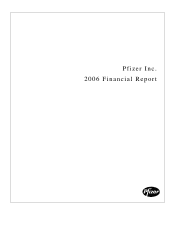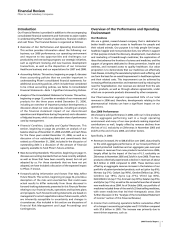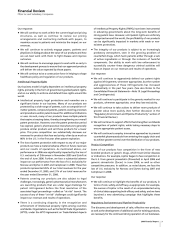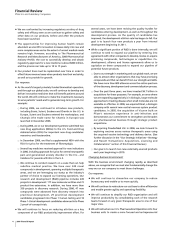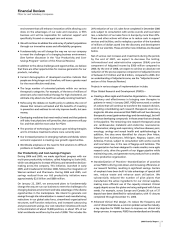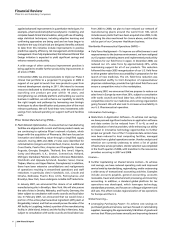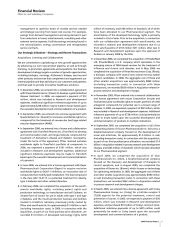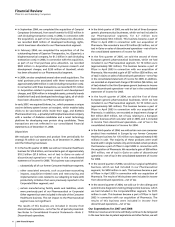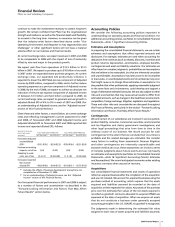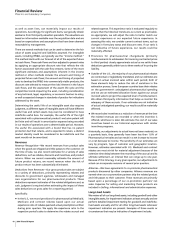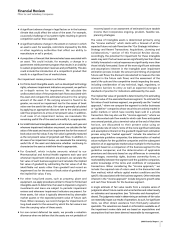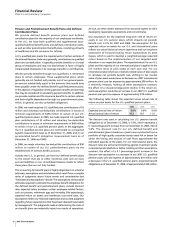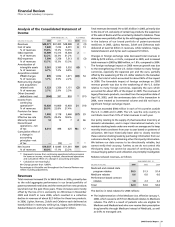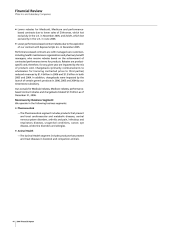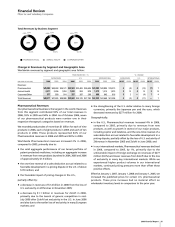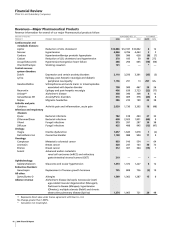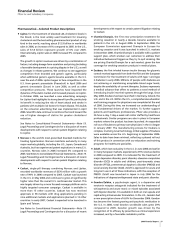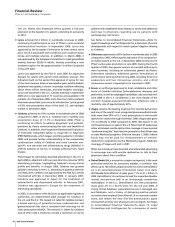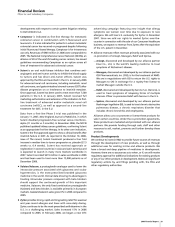Pfizer 2006 Annual Report Download - page 11
Download and view the complete annual report
Please find page 11 of the 2006 Pfizer annual report below. You can navigate through the pages in the report by either clicking on the pages listed below, or by using the keyword search tool below to find specific information within the annual report.
continue to make the investments necessary to sustain long-term
growth. We remain confident that Pfizer has the organizational
strength and resilience, as well as the financial depth and flexibility,
to succeed in the long term. However, no assurance can be given
that the industry-wide factors described above under “Our
Operating Environment and Response to Key Opportunities and
Challenges” or other significant factors will not have a material
adverse effect on our business and financial results.
At current exchange rates, we expect revenues in 2007 and 2008
to be comparable to 2006 with the impact of loss of exclusivity
offset by new and major in-line product growth.
We expect cash flow from operations of $12.5 billion to $13.5
billion in 2007. We expect to purchase up to $10 billion of our stock
in 2007 under our expanded share-purchase program. At current
exchange rates, our expanded AtS productivity initiative is
expected to lower the 2007 SI&A pre-tax component of Adjusted
income by $500 million, compared to 2006, and to further reduce
operating expenses as a pre-tax component of Adjusted income
in 2008. By the end of 2008, we expect to achieve an absolute net
reduction of the pre-tax expense component of Adjusted income
of between $1.5 billion and $2.0 billion compared to 2006. At
current exchange rates, we expect to generate annual growth in
adjusted diluted EPS of 6% to 9% in each of 2007 and 2008. (For
an understanding of Adjusted income, see the “Adjusted Income”
section of this Financial Review.)
Given these and other factors, a reconciliation, at current exchange
rates and reflecting management’s current assessment for 2007
and 2008, of forecasted 2007 and 2008 Adjusted income and
Adjusted diluted EPS to forecasted 2007 and 2008 reported Net
income and reported diluted EPS, follows:
(BILLIONS OF DOLLARS,
FULL-YEAR 2007 FORECAST FULL-YEAR 2008 FORECAST
EXCEPT PER-SHARE
AMOUNTS)
NET INCOME
(a)
DILUTED EPS
(a)
NET INCOME
(a)
DILUTED EPS
(a)
Forecasted Adjusted
income/diluted
EPS
(b)
~$15.1-$15.6 ~$2.18-$2.25 ~$15.6-$16.6 ~$2.31-$2.45
Purchase accounting
impacts, net of tax (2.4) (0.35) (2.0) (0.30)
Adapting to scale
costs, net of tax (2.4-2.7) (0.35-0.38) (1.5-1.8) (0.22-0.26)
Forecasted reported
Net income/
diluted EPS ~$10.0-$10.8 ~$1.45-$1.55 ~$11.8-$13.1 ~$1.75-$1.93
(a)
Excludes the effects of business-development transactions not
completed as of December 31, 2006.
(b)
For an understanding of Adjusted income, see the “Adjusted
Income” section of this Financial Review.
Our forecasted financial performance in 2007 and 2008 is subject
to a number of factors and uncertainties—as described in the
“Forward-Looking Information and Factors That May Affect
Future Results” section below.
Accounting Policies
We consider the following accounting policies important in
understanding our operating results and financial condition. For
additional accounting policies, see Notes to Consolidated Financial
Statements—Note 1. Significant Accounting Policies.
Estimates and Assumptions
In preparing the consolidated financial statements, we use certain
estimates and assumptions that affect reported amounts and
disclosures. For example, estimates are used when accounting for
deductions from revenues (such as rebates, discounts, incentives and
product returns), depreciation, amortization, employee benefits,
contingencies and asset and liability valuations. Our estimates are
often based on complex judgments, probabilities and assumptions
that we believe to be reasonable, but that are inherently uncertain
and unpredictable. Assumptions may later prove to be incomplete
or inaccurate, or unanticipated events and circumstances may occur
that might cause us to change those estimates or assumptions. It is
also possible that other professionals, applying reasonable judgment
to the same facts and circumstances, could develop and support a
range of alternative estimated amounts. We are also subject to other
risks and uncertainties that may cause actual results to differ from
estimated amounts, such as changes in the healthcare environment,
competition, foreign exchange, litigation, legislation and regulations.
These and other risks and uncertainties are discussed throughout
this Financial Review, particularly in the section “Forward-Looking
Information and Factors That May Affect Future Results.”
Contingencies
We and certain of our subsidiaries are involved in various patent,
product liability, consumer, commercial, securities, environmental
and tax litigations and claims; government investigations; and
other legal proceedings that arise from time to time in the
ordinary course of our business. We record accruals for such
contingencies to the extent that we conclude their occurrence is
probable and the related damages are estimable. We consider
many factors in making these assessments. Because litigation
and other contingencies are inherently unpredictable and
excessive verdicts do occur, these assessments can involve a series
of complex judgments about future events and can rely heavily
on estimates and assumptions (see Notes to Consolidated Financial
Statements—Note 1B. Significant Accounting Policies: Estimates
and Assumptions). We record anticipated recoveries under existing
insurance contracts when assured of recovery.
Acquisitions
Our consolidated financial statements and results of operations
reflect an acquired business after the completion of the acquisition
and are not restated. We account for acquired businesses using the
purchase method of accounting, which requires that the assets
acquired and liabilities assumed be recorded at the date of
acquisition at their respective fair values. Any excess of the purchase
price over the estimated fair values of the net assets acquired is
recorded as goodwill. Amounts allocated to acquired IPR&D are
expensed at the date of acquisition. When we acquire net assets
that do not constitute a business under generally accepted
accounting principles in the U.S. (GAAP), no goodwill is recognized.
The judgments made in determining the estimated fair value
assigned to each class of assets acquired and liabilities assumed,
2006 Financial Report 9
Financial Review
Pfizer Inc and Subsidiary Companies

